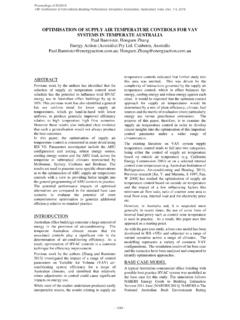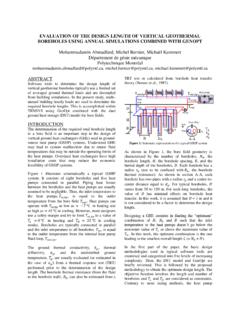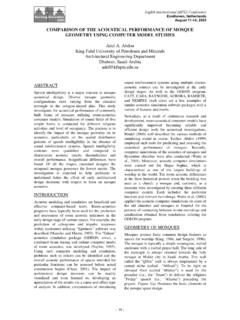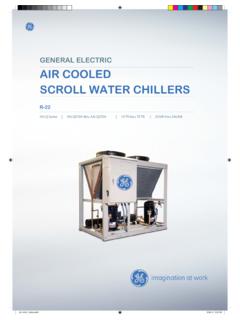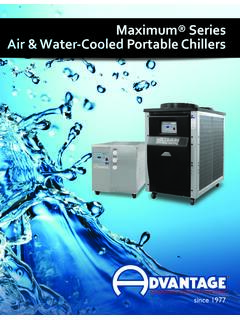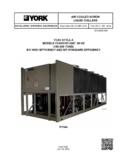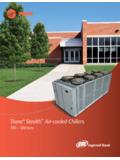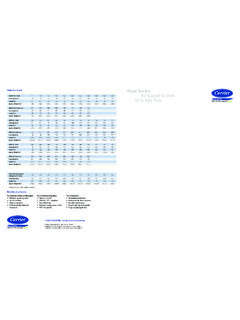Transcription of ENERGY PERFORMANCE OF CHILLERS WITH WATER MIST …
1 Proceedings of Building Simulation 2011: 12th Conference of International Building PERFORMANCE Simulation Association, Sydney, 14-16 November. ENERGY PERFORMANCE OF CHILLERS with WATER MIST ASSISTED. AIR- cooled CONDENSERS. Chan1, J. Yang1, and Yu2. 1. The Hong Kong Polytechnic University, Hong Kong, China 2. Hong Kong Community College, Hong Kong, China kept lower to minimize the compressor power and ABSTRACT hence to maximize the chiller COP. This paper reports how the coefficient of Currently, most of the air- cooled CHILLERS are PERFORMANCE (COP) of air- cooled CHILLERS can be equipped with constant speed condenser fans (CSF). improved by adopting variable condensing setpoint The extent of the condensing temperature decrease is temperature control and using mist evaporation to constrained by the dry-bulb temperature of outdoor pre-cool ambient air entering the condensers to air.
2 Evaporative cooling can reduce the air trigger a lower condensing temperature. chiller temperature from its dry bulb to wet bulb models without and with WATER mist system were temperature. Therefore, it is possible to improve the established, and the former was validated by using ENERGY efficiency of air- cooled CHILLERS by installing measured operating data of an installed screw chiller . WATER mist system to pre-cool the outdoor air before with the validated model, the ENERGY PERFORMANCE of entering condensers. The WATER mist pre-cooling air- cooled screw CHILLERS with twin refrigeration system is not a new concept, and has been applied circuits and WATER mist system serving a successfully in the industries (Cheung, Santos et al.)
3 Representative commercial building was studied. The 2006; Hsieh and Yao 2006; Zhang, Yongfeng et al. results reveal that the chiller COP can be changed by 2007). However, the application of WATER -mist various degrees from up to +72% depending system associated with a chiller system is not on the weather and load conditions, and the annual common, and a limited number of studies are found ENERGY consumption can be reduced by for a on the PERFORMANCE of CHILLERS with WATER mist commercial building in subtropical climate. system . Yu and Chan (2009) studied the application of WATER mist by simulation, which indicated that INTRODUCTION. WATER mist could improve chiller efficiency Air- cooled CHILLERS are commonly used to provide noticeably.
4 However, these models are developed cooling in commercial buildings, particularly in based on only one refrigeration circuit. densely populated cities in shortage of WATER , but The aim of this paper is to investigate the ENERGY with considerable electricity consumption (Yik, PERFORMANCE of air- cooled CHILLERS with twin Burnett et al. 2001). Low operational efficiency refrigeration circuits and the features of variable especially under partial load conditions and poor speed condenser fans, variable condensing control are part of the reasons for such huge ENERGY temperature control and WATER mist. A chiller plant consumption. The deficient PERFORMANCE of serving an air-conditioned office building was air- cooled CHILLERS is mainly due to head pressure considered in order to show the effects of each control (HPC).
5 HPC means that the number of staged feature on the annual electricity consumption of condenser fans is kept minimal in order to allow the CHILLERS . condensing temperature to hover around its high set point of 50oC. The condenser fan power under HPC MODEL DEVELOPMENT. can be minimized, but the chiller COP decreases One of the objectives is to investigate the chiller considerably when the chiller load drops in moderate PERFORMANCE under CTC, but there is a lack of such outdoor temperatures. Some researchers have stated operating data. Currently nearly all the air- cooled the opportunity to lower the condensing temperature CHILLERS operate under HPC, there is no reset of the to save compressor power to improve the operating condensing setpoint temperature at changes of efficiency of air- cooled CHILLERS (Manske, Reindl et operating conditions, and a detailed simulation of al.)
6 2001). All the condenser fans under variable chiller with twin refrigeration circuits is needed. condensing temperature control (CTC) are staged in most operating conditions. This causes an increase in the fan power, but the condensing temperature can be - 2088 - Proceedings of Building Simulation 2011: 12th Conference of International Building PERFORMANCE Simulation Association, Sydney, 14-16 November. System and model descriptions The cooling load of circuit 1 (Q1) is the sum of The air- cooled chiller plant installed in an cooling load of the two sections, institutional complex was investigated, which comprises of five identical CHILLERS connected in (4). parallel.
7 The chiller had a nominal cooling capacity of 1105 kW, and the rated electric power demand of each chiller was 398 kW. The chiller has two (5). identical refrigeration circuits in parallel and each circuit is equipped with an electronic expansion (6). valve and two screw compressors, which is shown in Figure 1. The air- cooled condenser contains 16 Where mw is the chilled WATER mass flow rate, Cw is identical condenser fans in eight groups to deliver a the specific heat capacity of WATER , Tchws1 and Tchwr1. total airflow rate of m3/s, and each refrigeration are the chilled WATER temperature entering and circuit operates with four fan groups. The power of leaving refrigeration circuit 2, respectively.
8 Each fan is kW and the total fan power is kW when all the condenser fans are operating. The The condensing setpoint temperature (Tcd) influences chiller operated under head pressure control with the heat rejection airflow required for any given constant speed condenser fans, and the operating cooling capacity and chiller PERFORMANCE . Heat variables were monitored by a building management rejection (Qcd) involves the ENERGY and mass balance system (BMS). in the condenser and is calculated by Eq. (7) and Eq. (8). Qcd could be met by modulating heat rejection airflow (Va) through staging different numbers of condenser fans or changing their speed. To control Tcd at its setpoint, Va has to comply with inequality (9).
9 The lower boundary of the required Va was given by Inequality (10) which is obtained from Inequality (9). Tcdsp was the set point of condensing temperature and was used to determine the staged condenser fans. For any Qcd, the number of staged condenser fans (Ncf) was determined by using Inequality (12), which Figure 1 Schematic of the air- cooled screw chiller was based on Eq. (11) and Inequality (10). Modelling of twin circuit CHILLERS (7). The chiller model was developed using the Transient Simulation Program TRNSYS, based on the field Qcd = Va a Cpa (Tcdal Tcdae) (8). chiller mentioned before. As this chiller has two identical refrigeration circuits, designated as 1 and 2, the chiller can operate with one refrigeration circuit (9).
10 Or both according to changes of cooling load. In this paper, in order to highlight the effect of variable condensing temperature control, the general control (10). strategy calls for one refrigeration circuit when chiller load is less than half of the rated chiller capacity and keeps the load of both circuits equal when the total chiller load is more than half of the (11). rated chiller capacity. The cooling load of the chiller can be expressed by the following equations, (1) (12). (2) To avoid having too much detail here, the other equations for the chiller components can be referred The cooling load of circuit 2 (Q2 ): to a previously reported chiller model (Chan and Yu 2006), which are applicable to each refrigeration (3) circuit.
